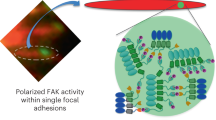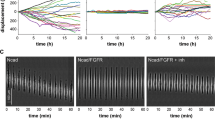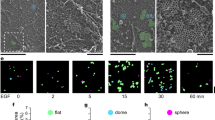Abstract
Here we show that cells lacking focal adhesion kinase (FAK) are refractory to motility signals from platelet-derived and epidermal growth factors (PDGF and EGF respectively), and that stable re-expression of FAK rescues these defects. FAK associates with activated PDGF- and EGF-receptor (PDGFR and EGFR) signalling complexes, and expression of the band-4.1-like domain at the FAK amino terminus is sufficient to mediate an interaction with activated EGFR. However, efficient EGF-stimulated cell migration also requires FAK to be targeted, by its carboxy-terminal domain, to sites of integrin-receptor clustering. Although the kinase activity of FAK is not needed to promote PDGF- or EGF-stimulated cell motility, kinase-inactive FAK is transphosphorylated at the indispensable Src-kinase-binding site, FAK Y397, after EGF stimulation of cells. Our results establish that FAK is an important receptor-proximal link between growth-factor-receptor and integrin signalling pathways.
This is a preview of subscription content, access via your institution
Access options
Subscribe to this journal
Receive 12 print issues and online access
$209.00 per year
only $17.42 per issue
Buy this article
- Purchase on Springer Link
- Instant access to full article PDF
Prices may be subject to local taxes which are calculated during checkout







Similar content being viewed by others
References
Schneller, M., Vuori, K. & Ruoslahti, E. αvβ3 integrin associates with activated insulin and PDGFβ receptors and potentiates the biological activity of PDGF. EMBO J. 16, 5600–5607 (1997).
Miyamoto, S., Teremoto, H., Gutkind, J. S. & Yamada, K. M. Integrins can collaborate with growth factors for phosphorylation of receptor tyrosine kinases and MAP kinase activation: roles of integrin aggregation and occupancy of receptors. J. Cell Biol. 135, 1633–1642 (1996).
Howe, A., Aplin, A. E., Alahari, S. K. & Juliano, R. L. Integrin signaling and cell growth control. Curr. Opin. Cell Biol. 10, 220–231 (1998).
Giancotti, F. G. & Ruoslahti, E. Integrin signaling . Science 285, 1028–1032 (1999).
Schwartz, M. A. & Baron, V. Interactions between mitogenic stimuli, or, a thousand and one connections. Curr. Opin. Cell Biol. 11, 197–202 (1999).
Hildebrand, J. D., Schaller, M. D. & Parsons, J. T. Identification of sequences required for the efficient localization of the focal adhesion kinase, pp125FAK, to cellular focal adhesions. J. Cell Biol. 123, 993– 1005 (1993).
Tachibana, K., Sato, T., D’Avirro, N. & Morimoto, C. Direct association of pp125FAK with paxillin, the focal adhesion-targeting mechanism of pp125FAK. J. Exp. Med. 182, 1089–1100 (1995).
Liu, S. et al. Binding of paxillin to alpha 4 integrins modifies integrin-dependent biological responses. Nature 402, 676– 681 (1999).
Chen, H. C. et al. Interaction of focal adhesion kinase with cytoskeletal protein talin. J. Biol. Chem. 270, 16995– 16999 (1995).
Schlaepfer, D. D. & Hunter, T. Evidence for in vivo phosphorylation of the Grb 2 SH 2-domain binding site on focal adhesion kinase by Src-family protein-tyrosine kinases. Mol. Cell. Biol. 16, 5623–5633 (1996).
Schlaepfer, D. D., Hauck, C. R. & Sieg, D. J. Signaling through focal adhesion kinase. Prog. Biophys. Mol. Biol. 71, 435– 478 (1999).
Tamura, M. et al. Inhibition of cell migration, spreading, and focal adhesions by tumor suppressor PTEN. Science 280, 1614 –1617 (1998).
Gu, J. et al. Shc and FAK differentially regulate cell motility and directionality modulated by PTEN. J Cell Biol. 146, 389 –404 (1999).
Sieg, D. J. et al. Pyk2 and Src-family protein-tyrosine kinases compensate for the loss of FAK in fibronectin-stimulated signaling events but Pyk2 does not fully function to enhance FAK- cell migration. EMBO J. 17, 5933–5947 (1998).
Sieg, D. J., Hauck, C. R. & Schlaepfer, D. D. Required role of focal adhesion kinase (FAK) for integrin-stimulated cell migration. J. Cell Sci. 112 , 2677–2691 (1999).
Owen, J. D., Ruest, P. J., Fry, D. W. & Hanks, S. K. Induced focal adhesion kinase (FAK) expression in FAK-null cells enhances cell spreading and migration requiring both auto- and activation loop phosphorylation sites and inhibits adhesion-dependent tyrosine phosphorylation of Pyk 2. Mol. Cell Biol. 19, 4806–4818 (1999).
Cary, L. A., Han, D. C., Polte, T. R., Hanks, S. K. & Guan, J.-L. Identification of p130Cas as a mediator of focal adhesion kinase-promoted cell migration. J. Cell Biol. 140, 211–221 (1998).
Gilmore, A. P. & Romer, L. H. Inhibition of focal adhesion kinase (FAK) signaling in focal adhesions decreases cell motility and proliferation. Mol. Biol. Cell 7, 1209 –1224 (1996).
George, E. L., Georges-Labouesse, E. N., Patel-King, R. S., Rayburn, H. & Hynes, R. O. Defects in mesoderm, neural tube and vascular development in mouse embryos lacking fibronectin . Development 119, 1079– 1091 (1993).
Furuta, Y. et al. Mesodermal defect in late phase of gastrulation by a targeted mutation of focal adhesion kinase, FAK. Oncogene 11 , 1989–1995 (1995).
Ilic, D. et al. Reduced cell motility and enhanced focal adhesion contact formation in cells from FAK-deficient mice. Nature 377, 539–544 (1995).
Chen, H. C. & Guan, J. L. The association of focal adhesion kinase with a 200-kDa protein that is tyrosine phosphorylated in response to platelet-derived growth factor. Eur. J. Biochem. 235, 495–500 (1996).
Salazar, E. P. & Rozengurt, E. Bombesin and platelet-derived growth factor induce association of endogenous focal adhesion kinase with Src in intact Swiss 3T3 cells. J. Biol. Chem. 274, 28371–28378 (1999).
Schlaepfer, D. D., Jones, K. C. & Hunter, T. Multiple Grb2-mediated integrin-stimulated signaling pathways to ERK 2/mitogen-activated protein kinase: Summation of both c-Src and FAK-initiated tyrosine phosphorylation events. Mol. Cell Biol. 18, 2571–2585 (1998).
Chen, H. C., Appeddu, P. A., Isoda, H. & Guan, J. L. Phosphorylation of tyrosine 397 in focal adhesion kinase is required for binding phosphatidylinositol 3-kinase. J. Biol. Chem 271, 26329–26334 (1996).
Manes, S. et al. Concerted activity of tyrosine phosphatase SHP-2 and focal adhesion kinase in regulation of cell motility. Mol. Cell Biol. 19, 3125–3135 (1999).
Zhang, X. et al. Focal adhesion kinase promotes phospholipase C-gamma 1 activity . Proc. Natl Acad. Sci. USA 96, 9021– 9026 (1999).
Han, D. C. & Guan, J. L. Association of focal adhesion kinase with grb7 and its role in cell migration. J. Biol. Chem. 274, 24425–24430 (1999).
Schaller, M. D., Otey, C. A., Hildebrand, J. D. & Parsons, J. T. Focal adhesion kinase and paxillin bind peptides mimicking β integrin cytoplasmic domains. J. Cell Biol. 130, 1181–1187 (1995).
Girault, J. A., Labesse, G., Mornon, J. P. & Callebaut, I. The N-termini of FAK and JAKs contain divergent band 4.1 domains. Trends Biochem. Sci. 24, 54–57 (1999).
Lev, S. et al. Identification of a novel family of targets of PYK2 related to Drosophila retinal degeneration B (rdgB) protein. Mol. Cell. Biol. 19, 2278–2288 (1999).
Richardson, A. & Parsons, J. T. A mechanism for regulation of the adhesion-associated protein tyrosine kinase pp125FAK. Nature 380, 538– 540 (1996).
Cicala, C. et al. Induction of phosphorylation and intracellular association of CC chemokine receptor 5 and focal adhesion kinase in primary human CD4+ T cells by macrophage-tropic HIV envelope. J. Immunol. 163, 420–426 (1999).
Miao, H., Burnett, E., Kinch, M., Simon, E. & Wang, B. Activation of EphA2 kinase suppresses integrin function and causes focal adhesion kinase dephosphorylation. Nature Cell Biol. 2, 62–69 (2000).
Fincham, V. J. & Frame, M. C. The catalytic activity of Src is dispensable for translocation to focal adhesions but controls the turnover of these structures during cell motility. EMBO J. 17, 81–92 (1998).
Brunton, V. G., Ozanne, B. W., Paraskeva, C. & Frame, M. C. A role for epidermal growth factor receptor, c-Src and focal adhesion kinase in an in vitro model for the progression of colon cancer. Oncogene 14, 283–293 (1997).
Owens, L. V. et al. Overexpression of the focal adhesion kinase (p125FAK) in invasive human tumors. Cancer Res. 55, 2752– 2755 (1995).
Kornberg, L. J. Focal adhesion kinase and its potential involvement in tumor invasion and metastasis. Head Neck 20, 745– 752 (1998).
Agochiya, M. et al. Increased dosage and amplification of the focal adhesion kinase gene in human cancer cells. Oncogene 18, 5646–5653 (1999).
Schlaepfer, D. D., Broome, M. A. & Hunter, T. Fibronectin-stimulated signaling from a focal adhesion kinase- c-Src complex: involvement of the Grb 2, p130Cas, and Nck adaptor proteins. Mol. Cell Biol. 17, 1702–1713 (1997).
Acknowledgements
We thank A. Moore and S. Reider for assistance, M. Schwartz for polyclonal antiserum directed to β1 integrins, T. Hunter for the PDGFR-β-expression vector and polyclonal antibodies to the PDGFRβ, B. Mayer for the pEBG mammalian GST-fusion expression vector and J.-L. Guan for the HA-tagged FAK(ΔC14) expression vector. This work was supported by National Cancer Institute, American Cancer Society and American Heart Association grants to D.D.S. D.J.S was supported by an NIH postdoctoral training grant; C.R.H by the Deutsche Forschungsgemeinschaft (HA-2856/1-1); D.I. by the UCSF Academic Senate; and C.H.D by the American Heart Association.
Correspondence and requests for materials should be addressed to D.D.S.
Author information
Authors and Affiliations
Corresponding author
Supplementary information
Figure S1
Comparisons of the expression levels of FAK, Pyk2, EGF receptor (EGFR), PDGF receptor (PDGFR) and p130 Cas in FAK+/+, FAK-/- and DA2 cells. All cells are p53-/-. (PDF 71 kb)
Figure S2 In vivo recruitment of FAK to apical attachment sites of beads coated with fibronectin (FN), EGF or fibronectin and EGF (FN+EGF) in DA2 and FAK+/+ fibroblasts.
Rights and permissions
About this article
Cite this article
Sieg, D., Hauck, C., Ilic, D. et al. FAK integrates growth-factor and integrin signals to promote cell migration . Nat Cell Biol 2, 249–256 (2000). https://doi.org/10.1038/35010517
Received:
Revised:
Accepted:
Published:
Issue Date:
DOI: https://doi.org/10.1038/35010517
This article is cited by
-
ZDHHC5-mediated S-palmitoylation of FAK promotes its membrane localization and epithelial-mesenchymal transition in glioma
Cell Communication and Signaling (2024)
-
ID4-dependent secretion of VEGFA enhances the invasion capability of breast cancer cells and activates YAP/TAZ via integrin β3-VEGFR2 interaction
Cell Death & Disease (2024)
-
The suppression of cell motility through the reduction of FAK activity and expression of cell adhesion proteins by hAMSCs secretome in MDA-MB-231 breast cancer cells
Investigational New Drugs (2024)
-
pH-regulated single cell migration
Pflügers Archiv - European Journal of Physiology (2024)
-
MFI2 upregulation promotes malignant progression through EGF/FAK signaling in oral cavity squamous cell carcinoma
Cancer Cell International (2023)



